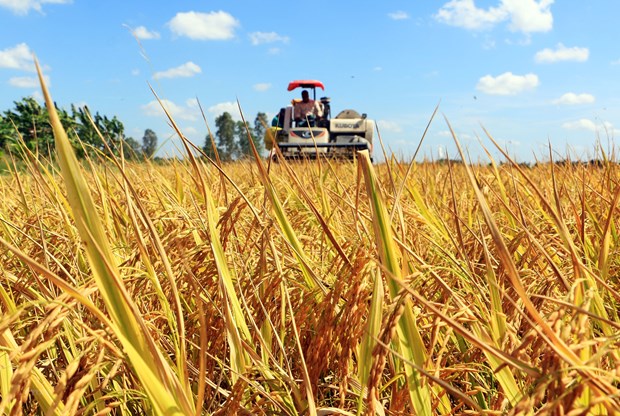
About 4.27 million tonnes of rice worth 2.3 billion USD was exported in the first half of 2023. (Photo: nongnghiep.vn)
About 6.6 million tonnes of milled rice in the Mekong Delta, the biggest rice production centre of Vietnam, is planned to be exported in 2023, including 3 million tonnes of high-quality rice, 2.1 million tonnes of fragrant and specialty rice, 0.9 million tonne of medium-quality rice, and 0.6 million tonnes of glutinous rice.
In the first six months of 2023, about 4.27 million tonnes of rice worth 2.3 billion USD was shipped abroad, rising 22.2% in volume and 34.7% in value year on year. Export prices averaged 539 USD per tonne, up 10.2%, according to the Quality, Processing and Market Development Department under the Ministry of Agriculture and Rural Development (MARD).
Favourable conditions are now in place for rice export, especially during the second half of 2023, as major markets like China, the Philippines, and Malaysia are still purchasing large volumes of the grain.
However, there is not much room left to boost the export volume. Vietnam is also stepping up crop restructuring to convert ineffective rice farming land into areas for other crops. Given this, promoting the rice value chain and processing to raise the produce’s value is compulsory to raise export revenue.
A representative of the Loc Troi Group said that to further increase rice value, aside from varieties and cultivation techniques, it is necessary to pay attention to processing and export markets. Importers have high demand for deeply processed rice, but Vietnamese businesses haven’t gained enough capital to invest in this step. Meanwhile, the weakness in origin tracing has also led to low prices.
In terms of brand building, the Loc Troi-branded rice is priced at up to 4,000 USD per tonne in the EU while the normal grain is sold at about 800 - 900 USD per tonne. The price difference is attributed to the shortage of capital to develop production and storage.
The sector also lacks information about markets. With sufficient and updated information, Vietnam can seize opportunities, the Loc Troi representative added.
Truong Sy Ba, Chairman of the Tan Long Group, pointed out problems in post-harvest preservation, noting that the rate of lost-harvest losses is still high, about 10 - 30% (depending on weather conditions).
In addition, the Mekong Delta is also facing logistics-related weaknesses. Rice must be dried within five - seven hours at the latest after being harvested to ensure good quality. However, due to poor and long transport, the product sometimes is dried after even 24 hours, making it hard to ensure quality.
Logistics is critical to reducing post-harvest losses, Ba went on.
The MARD is stepping up the building of a plan on sustainably developing 1 million hectares of land specialised in high-quality rice farming in connection with green growth in the Mekong Delta.
With this plan, Vietnam will be the first country to connect rice production with green growth, according to Le Thanh Tung, Deputy Director of the MARD’s Crop Production Department.
Ba held that the plan will help the sector improve rice productivity and quality and have competitive production costs.
For her part, Bui Thi Thanh Tam, Vice Chairwoman of the Vietnam Food Association, underlined the importance of quality, and that Vietnam should not wait for other countries to issue requirements but needs to proactively develop quality and brands.
Mentioning the issue of capital, she said banks have provided considerable assistance for rice businesses, but it is still very difficult for the companies to access bank loans as their assets are not big enough to be used as collateral.
The association called for increasing short-term loans for businesses during harvest periods, and helping them access the loans with low interest rates so that they can purchase rice in a timely manner to serve production./.
VNA
 Central bank mulls raising gold position limit for lenders
Central bank mulls raising gold position limit for lenders



